Atkinson K. An Introduction to Numerical Analysis
Подождите немного. Документ загружается.

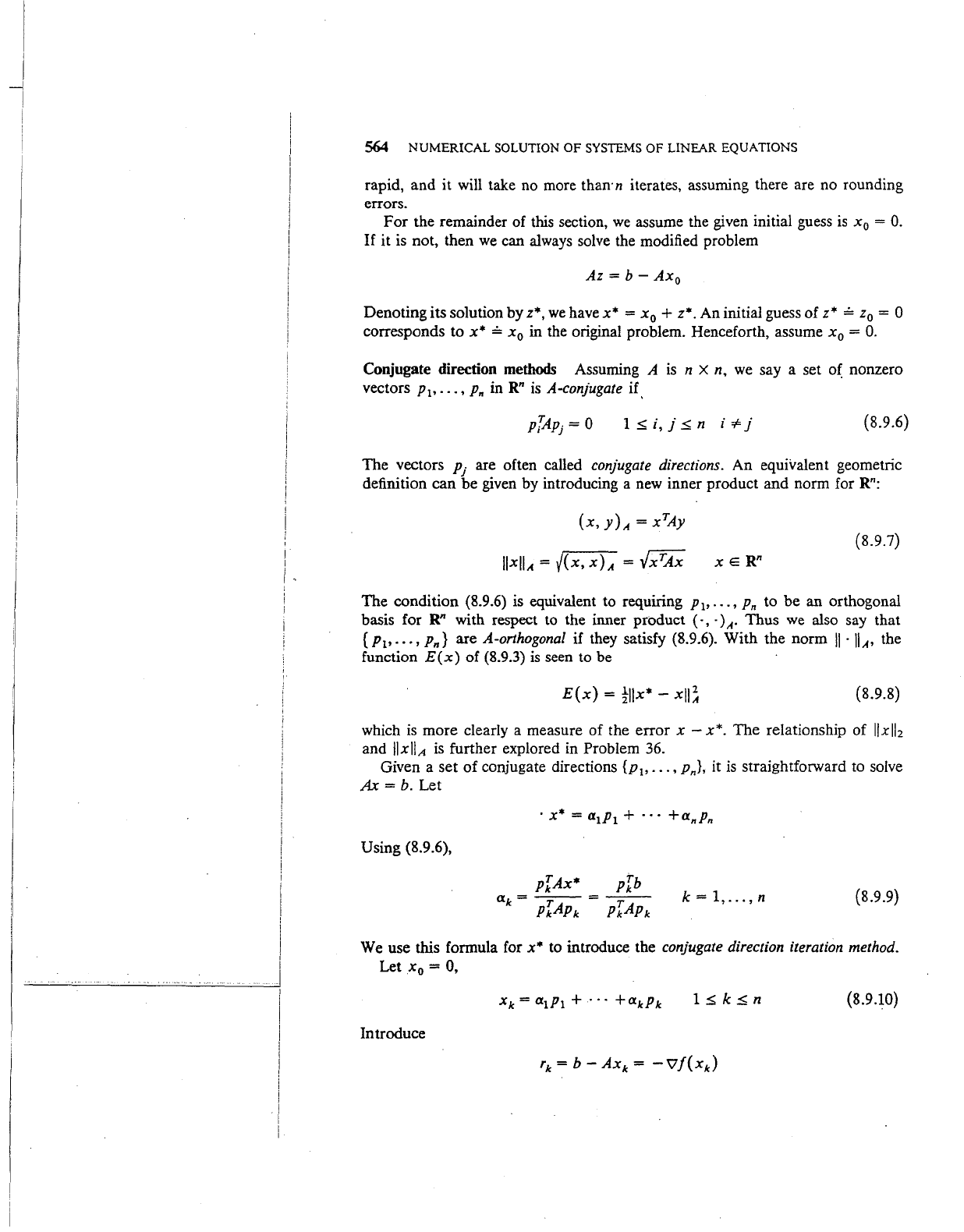
564
NUMERICAL SOLUTION OF SYSTEMS OF LINEAR EQUATIONS
rapid,
and
it will take no more than·n iterates, assuming there are no rounding
errors.
For
the remainder of this section,
we
assume the given initial guess
is
x
0
= 0.
If
it is not, then
we
can always solve the modified problem
Az
=
b-
Ax
0
Denoting its solution
by
z*,
we
have
x•
= x
0
+ z*. An initial guess
of
z*
= z
0
= 0
corresponds to
x•
= x
0
in the original problem. Henceforth, assume x
0
= 0.
Conjugate direction methods Assuming A
is
n X n,
we
say a set o( nonzero
vectors
PI•
...
,
p,
in
R"
is
A-conjugate if.
l.:s;;i,j.:s;;n
i=Fj
(8.9.6)
The
vectors
pj
are often called conjugate directions. An equivalent geometric
definition
can
be
given
by
introducing a new inner product
and
norm for
R":
(8.9.7)
The
condition (8.9.6) is equivalent to requiring PI•
...
,
p,
to
be
an
orthogonal
basis for
R"
with respect to the inner
product
(
·,
·)A·
Thus
we also say
that
{ PI•
...
,
p,}
are
A-orthogonal
if
they satisfy (8.9.6).
With
the
norm
II
·
II
A•
the
function
E(x)
of
(8.9.3)
is
seen to be
E(x)
=
tllx*-
xll~
(8.9.8)
which
is
more
clearly a measure
of
the
error
x -
x*.
The
relationship
of
llxll
2
and
llxiiA
is
further explored in Problem 36.
Given a
set
of
conjugate directions
{p
1
,
•••
,
p,},
it
is
straightforward to solve
Ax=
b.
Let
Using (8.9 .6),
k = 1,
...
, n
(8.9.9)
We use this formula for x* to introduce the conjugate direction iteration method.
Let x
0
= 0,
(8.9.10)
Introduce

THE CONJUGATE GRADIENT METHOD
565
the residual of
xk
in
Ax
= b. Easily, r
0
= b and
k=l,
...
,n
(8.9.11)
For
k =
n,
we have xn =
x*
and
rn
=
0,
and
xk may equal
x*
with a smaller
value
of
k.
Lemma 1 The term
rk
is orthogonal to
h·
...
,
Pk•
that is, r{p; =
0,
1
.:::;;
i.:::;;
k.
We leave the proof to Problem
37.
Lemma 2 (a) The minimization problem
is solved uniquely by a = ak, yielding
f(xk)
as the minimum.
(b) Let !?k = Span { p
1
,
••.
,
pd,
the k-dimensional subspace gen-
erated by { p
1
,
•••
, p k } • Then
the
problem
Minf(x)
xe.Y'k
is uniquely solved by x =
xk,
yielding the minimum
f(xk).
Proof
(a) Expand cp(a) =
f(xk-l
+
apk):
The
term
p[Axk-l
equals 0, because
xk_
1
E !7k_
1
and
Pk
is
A-
orthogonal to
sPk_
1
.
Solve cp'(a) = 0, obtaining a = ak, to complete the
proof.
(b) Expand
f(xk
+h),
for any h E
sPk:
f(xk
+h)=
f(xk)
+ hTAxk +
th-r.Ah-
hTb
By
Lemma 1
andthe
assumption h E
sPk,
It
follows that hTrk =
0.
Thus
since A is positive definite.
The
minimum is attained uniquely in
sPk
by
letting h = 0, proving (b). •
Lemma 2 gives
an
optimality property for conjugate direction methods,
defined
by
(8.9.11) and (8.9.9). The problem is knowing how
to
choose the
conjugate directions {
pj
}. There are many possible choices, and some of them
lead to well-known methods for directly solving
Ax=
b [see Stewart (1973b)].
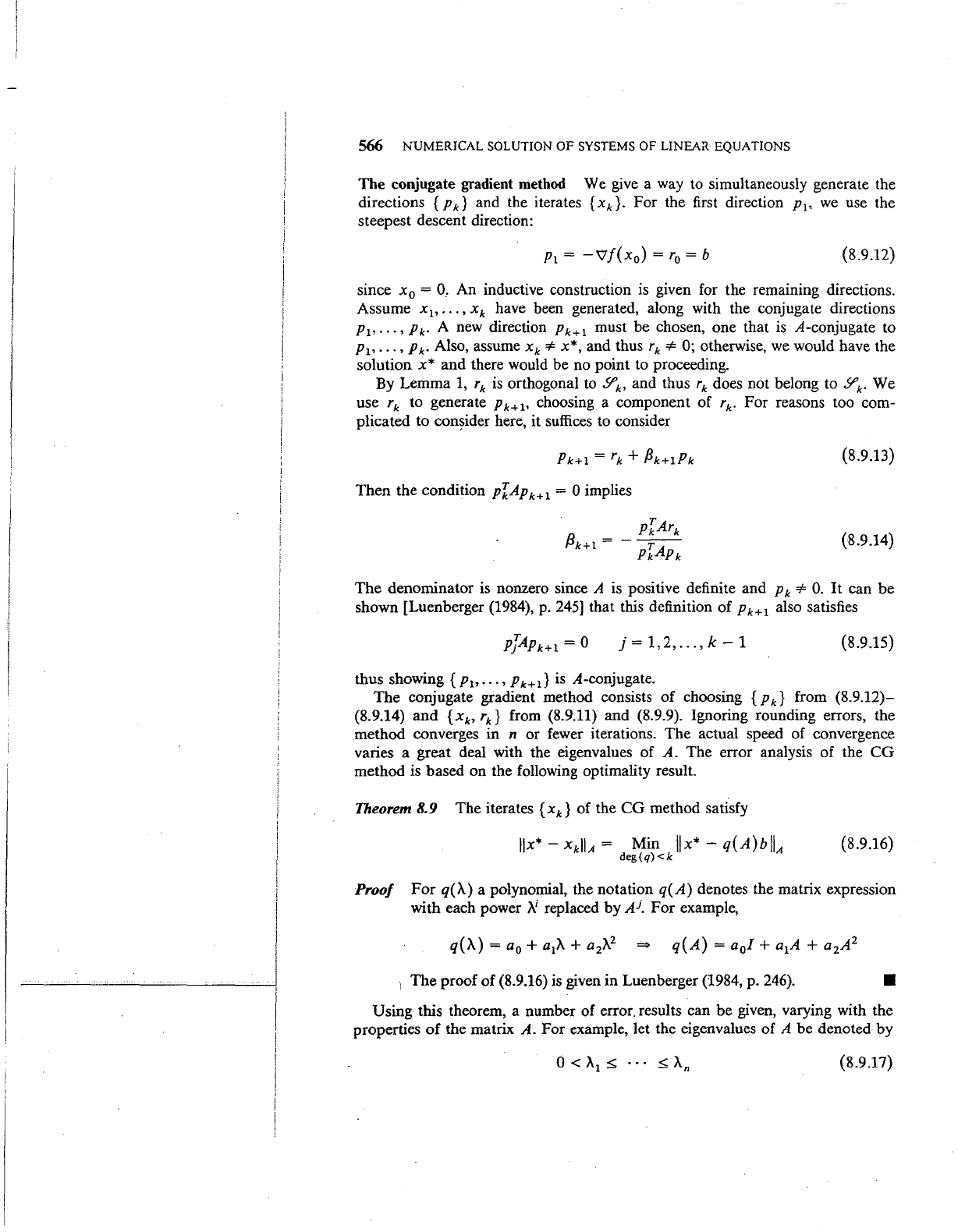
566
NUMERICAL
SOLUTION
OF
SYSTEMS OF LINEAR EQUATIONS
The conjugate gradient method
We
give
a
way
to simultaneously generate the
directions
{Pk}
and the iterates
{xd.
For the first direction p
1
,
we
use the
steepest descent direction:
(8.9.12)
since x
0
=
0,
An inductive construction is given for the remaining directions.
Assume
xi,
...
,
x"
have been generated, along with the conjugate directions
PI•
...
,
P1c·
A
new
direction
Pic+
I must be chosen, one that
is
A-conjugate to
PI•
...
,
P1c·
Also, assume x"
'*
x*, and
thus'"'*
0; otherwise, we would have the
solution
x*
and there would be no point to proceeding.
By
Lemma
1,
'"
is
orthogonal
to
!/'", and thus
'"
does not belong to !/'". We
use
rk
to generate
Pk+l•
choosing a component of
r".
For reasons too com-
plicated to
con~ider
here, it suffices to consider
(8.9.13)
Then the condition prApk+I = 0 implies
(8.9.14)
The
denominator
is
nonzero since A is positive definite and
PJc
=!=
0.
It
can be
shown [Luenberger
(1984),
p.
245]
that this definition of
Pk+I
also satisfies
pfApk+l = 0
j=1,2,
...
,k-1
(8.9.15)
thus showing { p
1
,
•..
,
P~c+d
is
A-conjugate.
The conjugate gradient method consists of choosing {
Pd from (8.9.12)-
(8.9.14)
and
{x~c,
rx} from (8.9.11) and (8.9.9). Ignoring rounding errors, the
method converges in
n or fewer iterations. The actual speed of convergence
varies a great deal with the eigenvalues of
A.
The error analysis of the
CG
method is based on the following optimality result.
Theorem 8.9 The iterates { x"} of the
CG
method satisfy
llx*-
X~cllA
= Min
llx*-
q(A)bjjA
deg(q)
<k
(8.9.16)
Proof
For
q('A)
a polynomial, the notation
q(A)
denotes the matrix expression
with each power
N replaced by
Aj.
For example,
1
The proof of (8.9.16)
is
given
in
Luenberger (1984, p.
246).
•
Using this theorem, a number of error. results can be given, varying with the
properties
of
the matrix
A.
For example, let the eigenvalues of A be denoted by
(8.9.17)
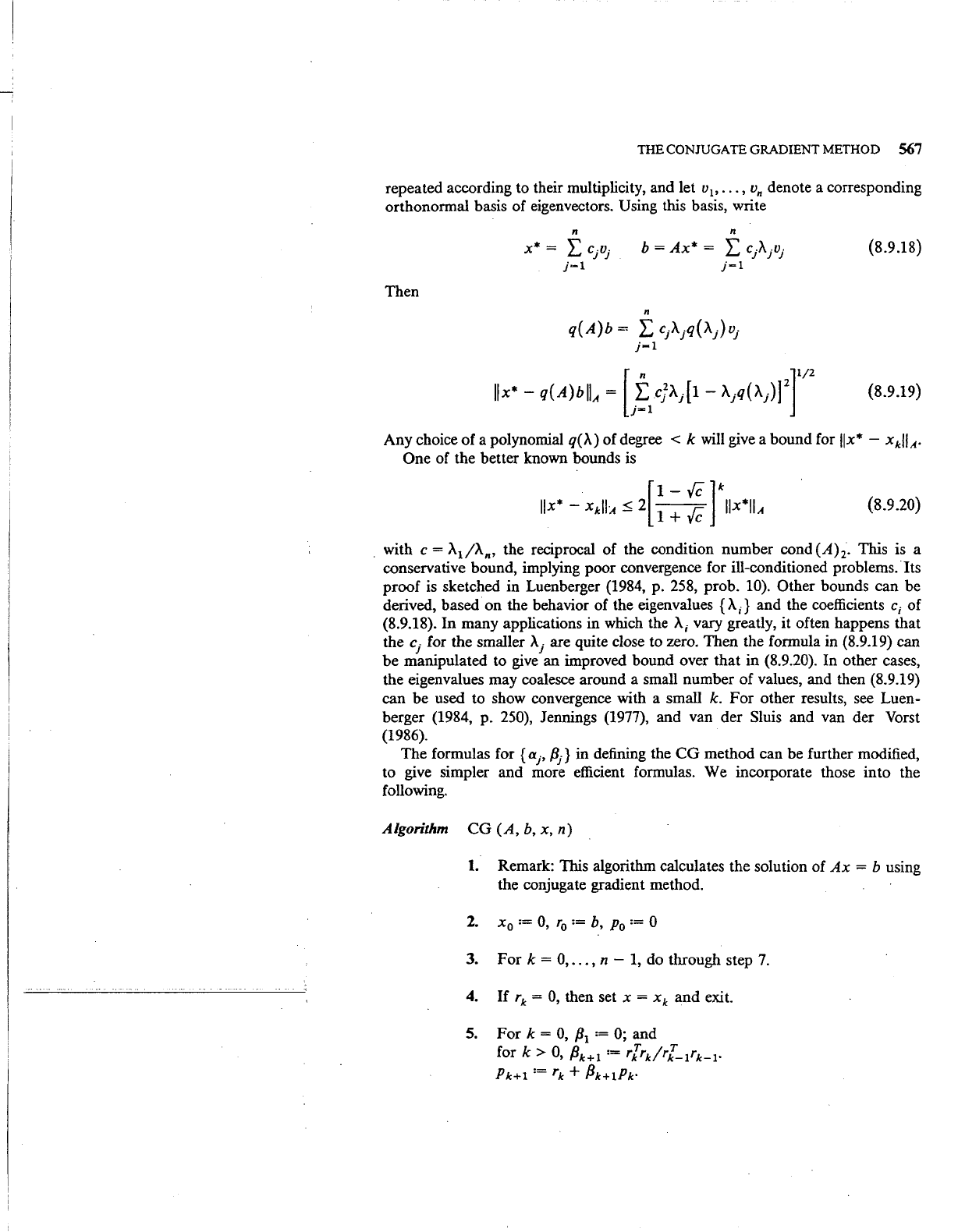
THE CONJUGATE GRADIENT METHOD 567
repeated according to their multiplicity, and let v
1
,
•..
,
vn
denote a corresponding
orthonormal basis of eigenvectors.
Using this basis, write
Then
n
x* = " c.v.
'-
J J
j-1
n
b=Ax*=
"c·A·D·
'-
J J J
j-1
n
q(A)b
= L
cjAjq(Aj)vj
j-1
(8.9.18)
(8.9.19)
Any choice of a polynomial
q(A)
of degree < k will give a bound for llx* -
xkll,
4
•
One of the better known bounds is
(8.9.20)
. with c =
AifAn,
the reciprocal of the condition number cond
(A
h. This is a
conservative bound, implying poor convergence for ill-conditioned
problems.· Its
proof is sketched in Luenberger (1984, p. 258, prob.
10). Other bounds can be
derived, based
on
the behavior of the eigenvalues {A;} and the coefficients
c;
of
(8.9.18). In many applications in which the
A;
vary greatly, it often happens that
the
cj for the smaller
Aj
are quite close to zero. Then the formula in (8.9.19) can
be manipulated to
give
an improved bound over that in (8.9.20). In other cases,
the eigenvalues may coalesce around a small number of values, and then (8.9.19)
can be used to show convergence with a small
k.
For
other results, see Luen-
berger (1984, p.
250), Jennings (1977), and van der Sluis and van der Vorst
(1986).
The formulas for {
aj,
Pj}
in defining the
CG
method can be further modified,
to give simpler and more efficient formulas. We incorporate those into the
following.
Algorithm
CG
(A,
b,
x,
n)
1.
Remark: This algorithm calculates the solution of
Ax
= b using
the conjugate gradient method.
2.
x
0
:=
0,
r
0
:=
b,
p
0
:=
0
3.
Fork=
0,
...
,
n-
1,
do through step
7.
4.
If
rk
=
0,
then set x = xk and exit.
5.
For
k =
0,
P
1
:= 0; and
fork>
0,
Pk+l := r'[rkfr[_
1
rk-I·
Pk+l
:=
rk
+ pk+1Pk·
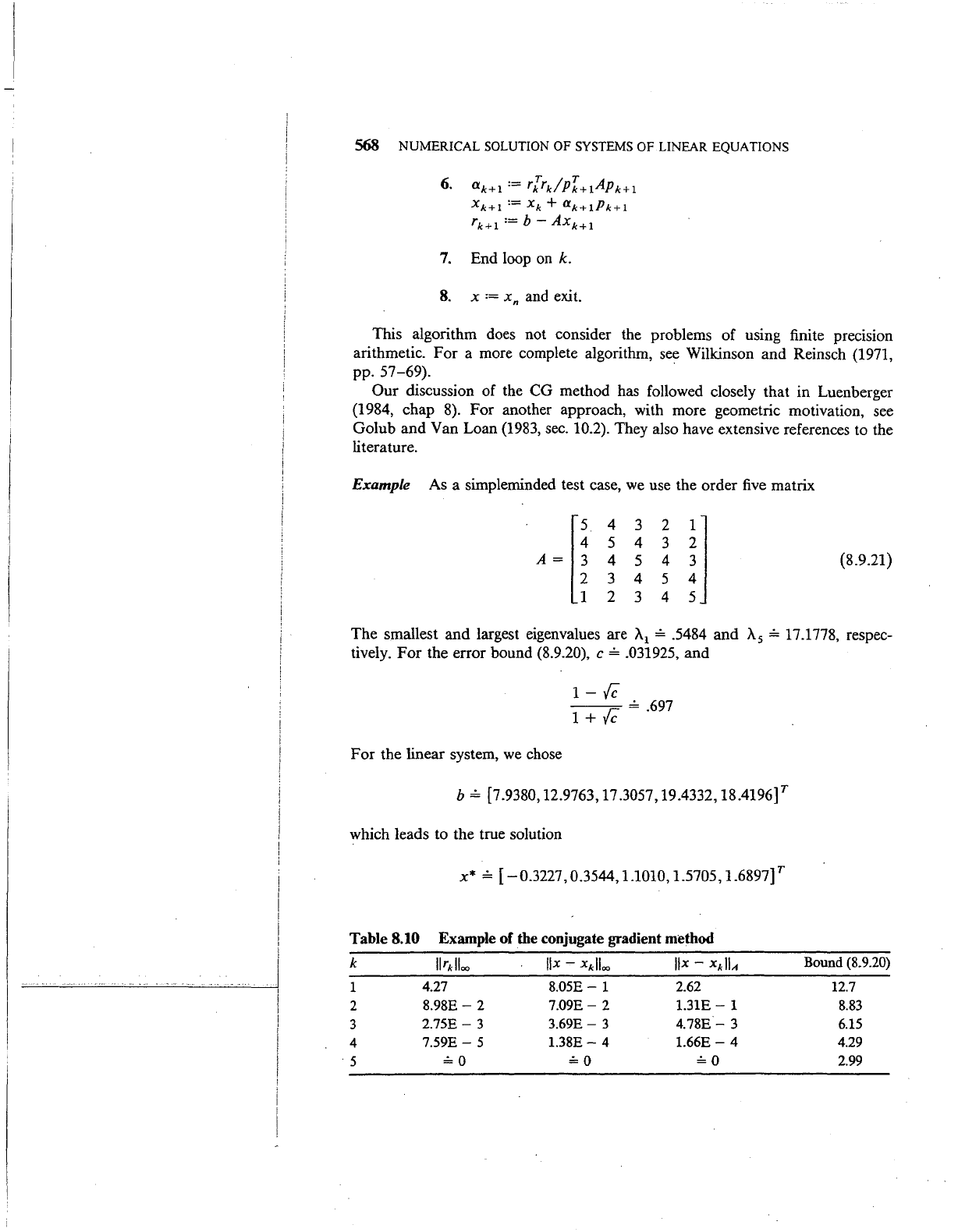
568
NUMERICAL SOLUTION OF SYSTEMS OF LINEAR EQUATIONS
6.
ak+l
==
r[rk!PLIAPk+l
xk+l
==
xk
+
ak+1Pk+1
rk+l
==
b-
Axk+l
7.
End loop
on
k.
8.
X
:=
Xn
and exit.
This algorithm does not consider the problems of using finite preclSlon
arithmetic. For a more complete algorithm,
see
Wilkinson and Reinsch (1971,
pp.
57-69~
.
Our
discussion of the CG method has followed closely that in Luenberger
(1984, chap 8). For another approach, with more geometric motivation, see
Golub and Van Loan
(1983, sec. 10.2). They also have extensive references to the
literature.
Example
As a simpleminded test case,
we
use the order
five
matrix
r5
4
3
2
~l
A~
~
5 4
3
4
5
4
(8.9.21)
3 4
5
2
3 4
The smallest and largest eigenvalues are
A.
1
= .5484 and
A.
5
= 17.1778, respec-
tively.
For
the error bound (8.9.20), c = .031925, and
1-
{C
'-
= .697
1 +
vc
For
the linear system,
we
chose
b = [7.9380, 12.9763,17.3057,19.4332,
18.4196f
which leads to the true solution
x* = [
-0.3227,0.3544,
1.1010, 1.5705,
1.6897f
Table 8.10 Example
of
the conjugate gradient method
k
llrklloo
llx-
xklloo
llx-
xkiiA
1
4.27
8.05E-
1 2.62
2
8.98E-
2
7.09E-
2
1.31E-
1
3
2.75E-
3
3.69E-
3
4.78E-
3
4
7.59E-
5
1.38E-
4
1.66E-
4
·5
=o
=o
=o
Bound (8.9.20)
12.7
8.83
6.15
4.29
2.99
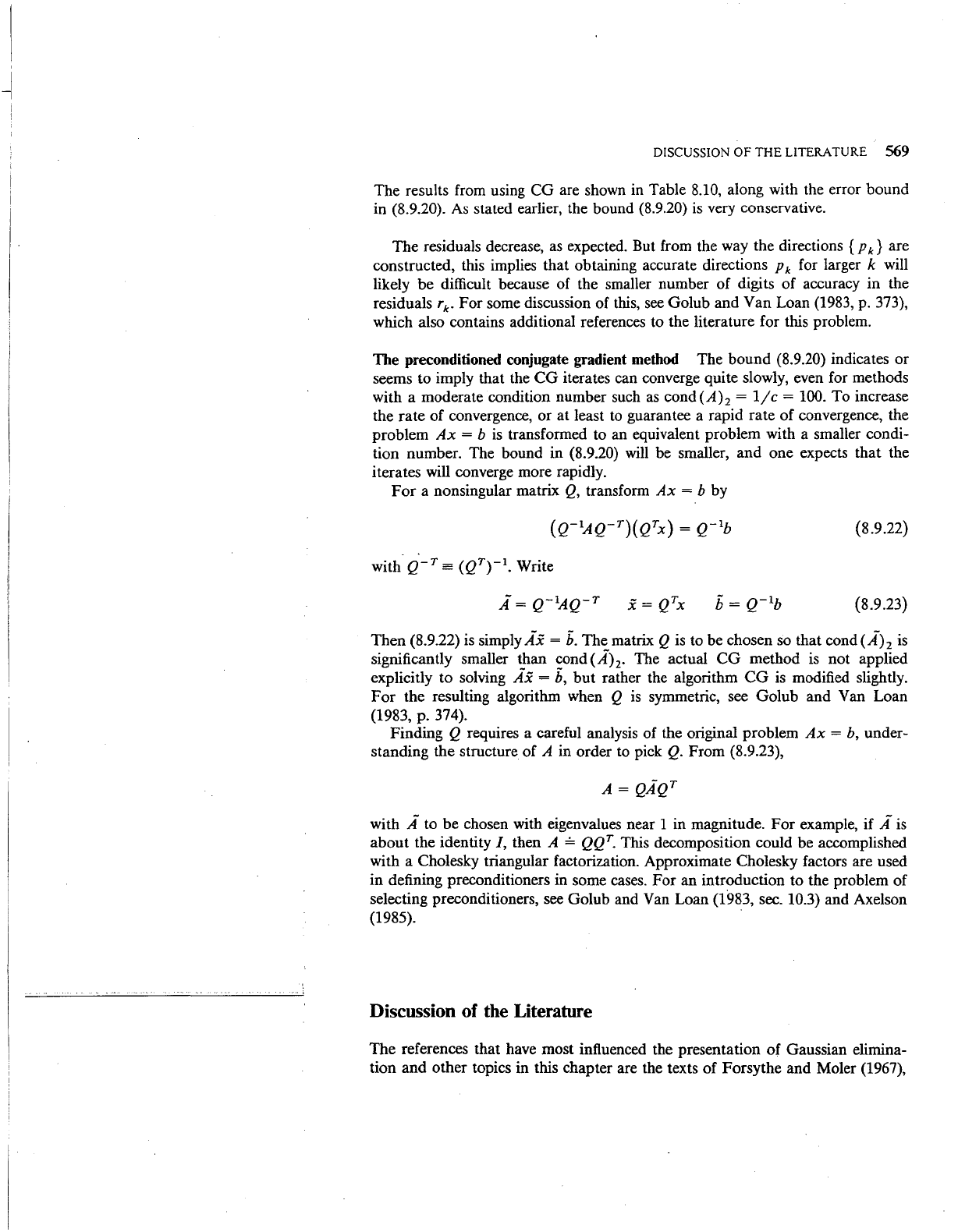
....
;
DISCUSSION
OF
THE
LITERATURE 569
The results from using CG are shown
in
Table 8.10, along with the error bound
in
(8.9.20).
As
stated earlier, the bound (8.9.20)
is
very conservative.
The residuals decrease, as expected. But from the way the directions { p
k } are
constructed, this implies that obtaining accurate directions
p k for larger k will
likely be difficult because of the smaller number of digits of accuracy in the
residuals
rk. For some discussion of this,
see
Golub and Van Loan (1983,
p.
373),
which also contains additional references to the literature for this problem.
The
preconditioned conjugate gradient method The bound (8.9.20) indicates or
seems to imply that the
CG
iterates can converge quite slowly, even for methods
with a moderate condition number such
as
cond(A}z =
1/c
= 100. To increase
the rate of convergence, or at least
to
guarantee a rapid rate of convergence, the
problem
Ax
= b
is
transformed to an equivalent problem with a smaller condi-
tion number. The bound in
(8.9.20)
will
be smaller, and one expects that the
iterates will converge more rapidly.
For
a nonsingular matrix
Q,
transform
Ax
= b by
(8.9.22)
(8.9.23)
Then (8.9.22)
is
simply
Ai
=b. The matrix Q
is
to be chosen so that cond(A}z
is
significantly smaller than cond
(Ah.
The actual
CG
method
is
not applied
explicitly to solving
Ai
=
b,
but rather the algorithm
CG
is
modified slightly.
For
the resulting algorithm when Q
is
symmetric, see Golub and Van Loan
(1983, p. 374).
Finding Q requires a careful analysis of the original problem
Ax
= b, under-
standing the structure of
A in order to pick
Q.
From (8.9.23),
with A to be chosen with eigenvalues near 1 in magnitude. For example, if A
is
about the identity I, then A =
QQT.
This decomposition could be accomplished
with a Cholesky triangular factorization. Approximate Cholesky factors are used
in defining preconditioners in some cases. For an introduction to the problem of
selecting preconditioners, see Golub and
Van Loan (1983, sec. 10.3) and Axelson
nru~
·
Discussion
of
the Literature
The references that have most influenced the presentation of Gaussian elimina-
tion and other topics in this chapter are the texts of Forsythe and Moler
(1967),

570 NUMERICAL SOLUTION OF SYSTEMS
OF
LINEAR EQUATIONS
Golub and Van Loan
(1983),
Isaacson and Keller
(1966),
and Wilkinson (1963),
(1965), along with the paper of Kahan (1966).
Other very good general treatments
are given
in
Conte and
de
Boor (1980), Noble (1969), Rice (1981), and Stewart
(1973a). More elementary introductions are given in Anton (1984) and
Strang
(1980).
The best codes for the direct solution of both general and special forms of
linear systems, of small to moderate size, are based on those given in the package
UNPACK,
described in Dongarra et
al.
(1979). These are completely portable
programs, and they are available in single and double precision, in both real and
complex arithmetic. Along with the solution of the systems, they also can
estimate the condition number of the matrix under consideration. The linear
equation programs in
IMSL and
NAG
are variants and improvements of the
programs
in
UNPACK.
Another feature of the
UNPACK
is
the use of the Basic Linear Algebra
Subroutines
(BLAS). These are low-level subprograms that carry out basic vector
operations, such as the dot product of two vectors and the sum
of
two vectors.
These are available in Fortran, as part
of
UNPACK;
but by giving assembly
language implementations of them, it
is
often possible to significantly improve
the efficiency of the main
UNPACK
programs. For a more general discussion of
the
BLAS, see Lawson et
al.
(1979). The
UNPACK
programs are widely
available, and they have greatly influenced the development of linear equation
programs
in
other packages.
There is a very large literature on solving the linear systems arising from the
numerical solution of partial differential equations
(PDEs).
For
some general
texts
on
the numerical solution of PDEs, see Birkhoff and Lynch (1984), Forsythe
and
Wasow (1960), Gladwell and Wait (1979), Lapidus and Pinder (1982), and
Richtmyer
and
Morton
(1967).
For
texts devoted to classical iterative methods
for solving the linear systems arising from the numerical solution of
PDEs, see
Hageman and
Young (1981) and Varga (1962). For other approaches of more
recent interest, see Swarztrauber (1984), Swarztrauber and
Sweet (1979), George
and
Liu (1981), and Hackbusch and Trottenberg (1982).
The numerical solution of
PDEs is the source of a large percentage of the
sparse linear systems that are solved
in
practice. However, sparse systems of large
order also occur with other applications [e.g., see Duff (1981)]. There
is
a large
variety of approaches to solving large sparse systems, some of which we·discussed
in
Sections 8.6-8.8. Other direct and iteration methods are available, depending
on
the structure of the matrix. For a sample of the current research
in
this very
active area, see the survey of Duff (1977), the proceedings of Bjorck et al. (1981),
Duff (1981), Duff and
Stewart (1979), and Evans (1985), and the texts of George
and Liu (1981) and
Pissanetzky (1984). There are several software packages for
the solution of various types
of· sparse systems, some associated with the
preceding books. For a general index of many of the packages that are available,
see the compilation of Heath (1982).
For
iteration methods for the systems
associated with solving partial differential equations, the books of Varga (1962)
and
Hageman and Young (1981) discuss many of the classical approaches.
Integral equations lead to dense linear systems, and other types of iteration
methods have been used for their solution. For some quite successful methods,
see Atkinson (1976, part II, chap. 4).
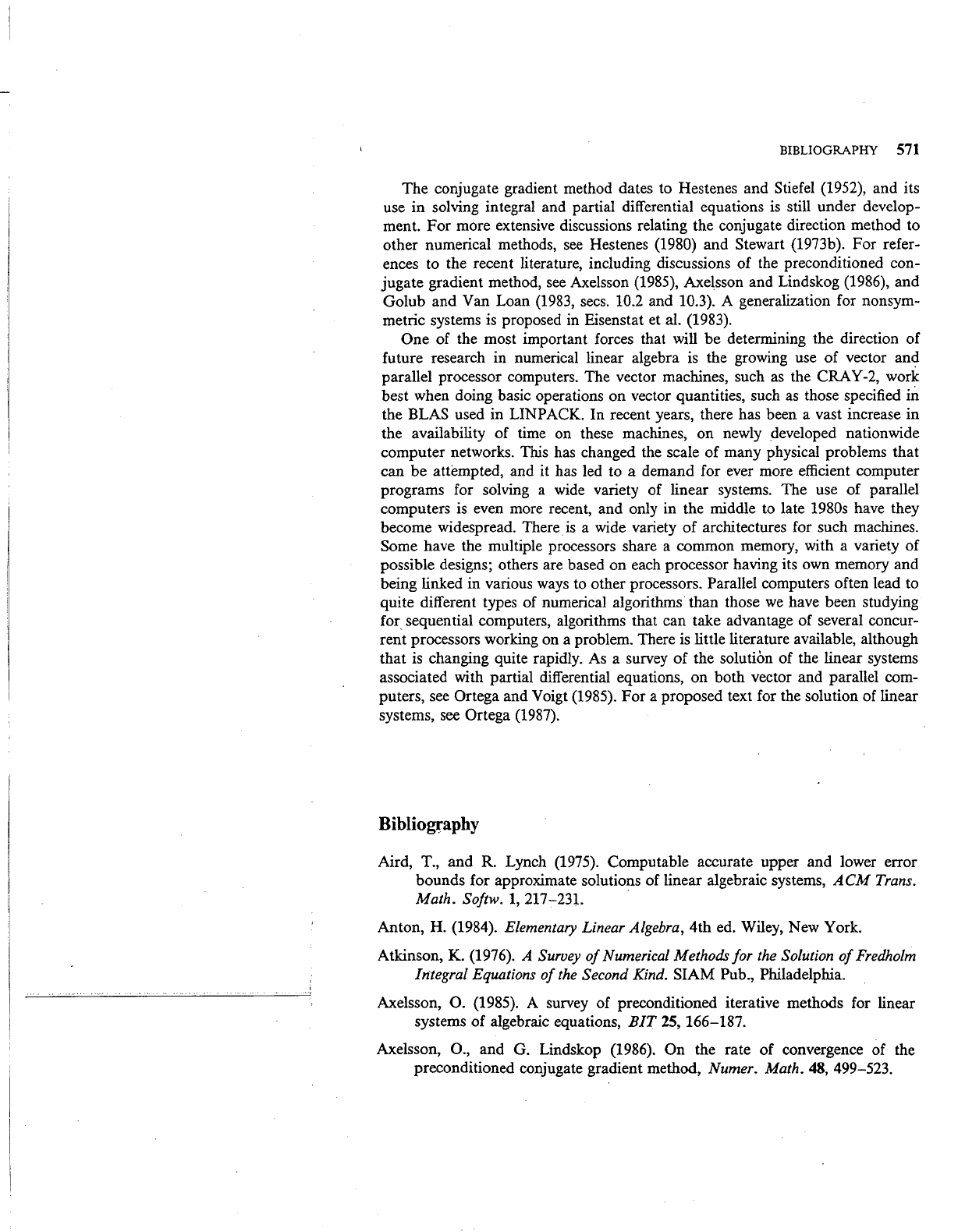
BIBLIOGRAPHY 571
The conjugate gradient method dates to Hestenes and Stiefel (1952), and its
use in solving integral and partial differential equations
is
still under develop-
ment. For more extensive discussions relating the conjugate direction method to
other numerical methods,
see
Hestenes (1980) and Stewart (1973b). For refer-
ences to the recent literature, including discussions of the preconditioned con-
jugate gradient method, see Axelsson (1985), Axelsson and Lindskog (1986), and
Golub and Van Loan
(1983,
sees.
10.2 and 10.3). A generalization for nonsym-
metric systems
is
proposed
in
Eisenstat et al. (1983).
One of the most important forces that will be determining the direction of
future research in numerical linear algebra
is
the growing use of vector and
parallel processor computers. The vector machines, such
as
the CRA Y-2, work
best when doing basic operations on vector quantities, such
as
those specified in
the BLAS used in UNPACK. In recent years, there has been a vast increase in
the availability of time on these machines, on newly developed nationwide
computer networks. This has changed the scale of many physical problems that
can be attempted, and it has led to a demand for ever more efficient computer
programs for solving a wide variety of linear systems. The use of parallel
computers is even more recent, and only in the middle to late 1980s have they
become widespread. There.
is
a wide variety
of
architectures for such machines.
Some have the multiple processors share a common memory, with a variety of
possible designs; others are based on each processor having its own memory and
being linked in various
ways
to other processors. Parallel computers often lead to
quite different types of numerical algorithms· than those
we
have been studying
for
sequential computers, algorithms that can take advantage of several concur-
rent processors working on a problem. There is little literature available, although
that
is
changing quite rapidly. As a survey of the solution of the linear systems
associated with partial differential equations, on both vector and parallel com-
puters, see Ortega and Voigt (1985). For a proposed text for the solution of linear
systems,
see
Ortega
(1987).
Biblio~aphy
Aird, T., and R. Lynch (1975). Computable accurate upper and lower error
bounds for approximate solutions of linear algebraic systems,
ACM
Trans.
Math. Softw.
1,
217-231. .
Anton, H. (1984). Elementary Linear Algebra, 4th ed. Wiley, New York.
Atkinson,
K.
(1976). A Survey
of
Numerical Methods for the Solution
of
Fredholm
Integral Equations
of
the Second Kind. SIAM Pub., Philadelphia.
Axelsson,
0.
(1985). A survey of preconditioned iterative methods for linear
systems of algebraic equations,
BIT
25,
166-187.
Axelsson,
0.,
and G. Lindskop (1986). On the rate of convergence of the
preconditioned conjugate gradient method,
Numer. Math. 48, 499-523.

572
NUMERICAL SOLUTION OF SYSTEMS OF LINEAR EQUATIONS
Birkhoff, G., and
R.
Lynch
(1984).
Numerical Solution
of
Elliptic Problems. SIAM
Pub., Philadelphia.
Bjorck, A., R. Plemmons, and
H.
Schneider, Eds. (1981). Large Scale Matrix
Problems.
North-Holland, Amsterdam.
Concus, P., G. Golub, and
D.
O'Leary
(1984).
A generalized conjugate gradient
method for the numerical solution of elliptic partial differential equations.
In
Studies
in
Numerical Analysis,
G.
Golub, Ed. Mathematical Association
of America, pp. 178-198.
Conte,
S.,
and C. de Boor
(1980).
Elementary Numerical Analysis,
.3rd
ed.
McGraw-Hill, New
York.
Dongarra, J., J. Bunch,
C.
Moler, and G. Stewart (1979). Linpack User's Guide.
SIAM Pub., Philadelphia.
Dorr, F.
(1970). The direct solution of the discrete Poisson equations on a
rectangle,
SIAM
Rev.
12,
248-263.
Duff,
I. (1977). A survey of sparse matrix research,
Proc.
IEEE
65,
500-535.
Duff, 1., Ed. (1981). Sparse Matrices and Their
Uses.
Academic Press, New York.
Duff, 1., and G. Stewart, Eds.
(1979).
Sparse Matrix Proceedings 1978. SIAM
Pub., Philadelphia.
Eisenstat,
S.,
H.
Elman, and
M.
Schultz
(1983).
Variational iterative methods for
nonsymmetric systems of linear equations,
SIAM
J. Numer. Anal.
20,
345-357.
Evans, D., Ed. (1985).
Sparsity and Its Applications. Cambridge Univ. Press,
Cambridge,
Engl~d:
Forsythe, G., and
C.
Moler (1967). Computer Solution
of
Linear Algebraic
Systems.
Prentice-Hall, Englewood Cliffs, N.J.
Forsythe, G., and
W.
Wasow (1960). Finite Difference Methods for Partial
Differential Equations.
Wiley,
New York.
George, A., and
J.
Liu
(1981).
Computer Solution
of
Large Sparse Positive Definite
Systems.
Prentice-Hall, Englewood Cliffs, N.J.
Gladwell,
L,
and
R.
Wait,
Eds.
(1979).
A Survey
of
Numerical Methods for Partial
Differential Equations.
Oxford Univ. Press, Oxford, England.
Golub, G., and
C.
Van Loan
(1983).
Matrix Computations. Johns Hopkins Press,
Baltimore.
Gregory, R., and D. Karney
(1969).
A Collection
of
Matrices for Testing Computa-
tional Algorithms.
Wiley,
New York.
Hackbusch, W., and U. Trottenberg, Eds. (1982). Multigrid Methods, Lecture
Notes Math.
960. Springer-Verlag, New York.
Hageman, L., and D. Young
(1981).
Applied Iterative Methods. Academic Press,
New
York.
Heath, M., Ed. (1982). Sparse Matrix Software Catalog. Oak Ridge National
Laboratory,
Oak Ridge, Tenn. (Published in connection with the Sparse
Matrix Symposium 1982.)
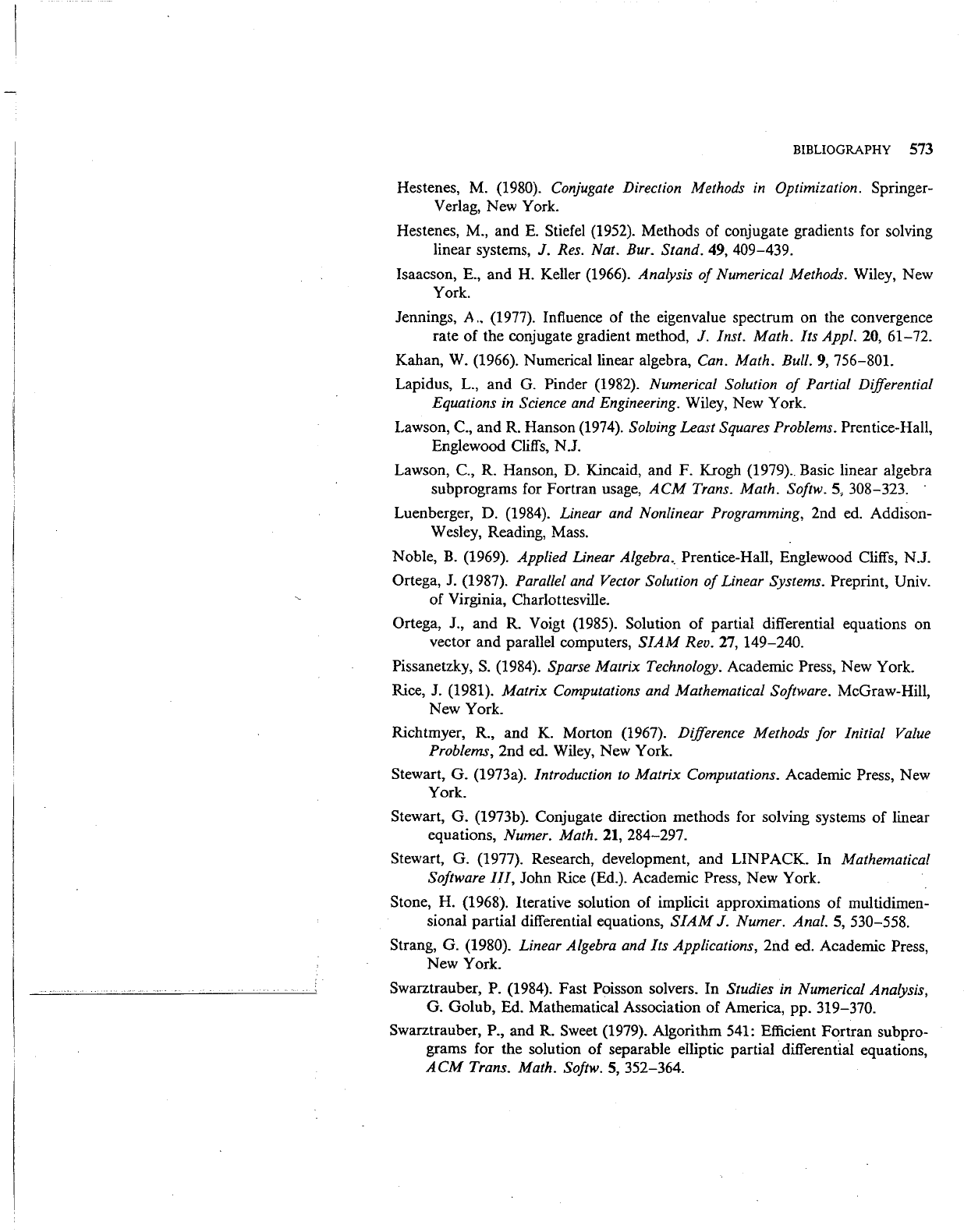
BIBLIOGRAPHY 573
Hestenes, M. (1980).
Conjugate Direction Methods
in
Optimization. Springer-
Verlag, New York.
Hestenes, M., and
E.
Stiefel (1952). Methods
of
conjugate gradients for solving
linear systems,
J. Res. Nat. Bur. Stand. 49, 409-439.
Isaacson, E.,
and
H. Keller (1966). Analysis
of
Numerical Methods. Wiley, New
York.
Jennings,
A
.•
(1977). Influence
of
the eigenvalue spectrum on the convergence
rate
of
the conjugate gradient method, J. lnst. Math. Its Appl. 20,
61-72.
Kahan, W. (1966). Numerical linear algebra, Can. Math. Bull.
9,
756-801.
Lapidus, L.,
and
G. Pinder (1982). Numerical Solution
of
Partial Differential
Equations in Science and Engineering.
Wiley, New York.
Lawson,
C.,
and
R. Hanson (1974). Solving Least Squares Problems. Prentice-Hall,
Englewood Cliffs, N.J.
Lawson,
C., R. Hanson, D. Kincaid, and F. Krogh (1979). Basic linear algebra
subprograms for Fortran usage,
ACM
Trans. Math. Softw. 5, 308-323. ·
Luenberger, D. (1984). Linear and Nonlinear Programming, 2nd ed. Addison-
Wesley, Reading, Mass.
Noble,
B.
(1969). Applied Linear Algebra
..
Prentice-Hall, Englewood Cliffs, N.J.
Ortega, J. (1987).
Parallel and Vector Solution
of
Linear Systems. Preprint, Univ.
of
Virginia, Charlottesville.
Ortega, J.,
and
R. Voigt (1985). Solution
of
partial differential equations
on
vector
and
parallel computers,
SIAM
Rev. 27, 149-240.
Pissanetzky,
S.
(1984). Sparse Matrix Technology. Academic Press, New York.
Rice, J. (1981).
Matrix Computations and Mathematical Software. McGraw-Hill,
New
York.
Richtmyer, R., and
K. Morton (1967). Difference Methods for Initial
Value
Problems, 2nd ed. Wiley, New York.
Stewart,
G.
(1973a). Introduction
to
Matrix Computations. Academic Press, New
York.
Stewart,
G.
(1973b). Conjugate direction methods for solving systems
of
linear
equations,
Numer. Math. 21, 284-297.
Stewart, G. (1977). Research, development, and
UNPACK.
In
Mathematical
Software
Ill,
John Rice (Ed.). Academic Press,
New
York.
Stone, H. (1968). Iterative solution
of
implicit approximations
of
multidimen-
sional partial differential equations,
SIAM
J. Numer. Anal. 5, 530-558.
Strang, G. (1980). Linear Algebra and Its Applications,
2nd
ed. Academic Press,
New York.
Swarztrauber, P. (1984). Fast Poisson solvers.
In
Studies
in
Numerical Analysis,
G. Golub, Ed. Mathematical Association
of
America, pp. 319-370.
Swarztrauber,
P., and R. Sweet (1979). Algorithm 541: Efficient
Fortran
subpro-
grams for the solution
of
separable elliptic partial differential equations,
ACM
Trans. Math. Softw. 5, 352-364.
